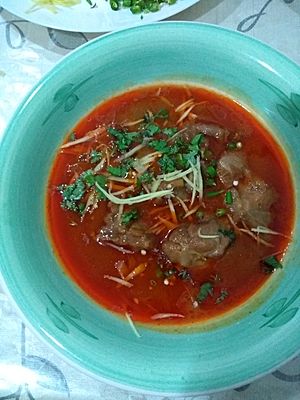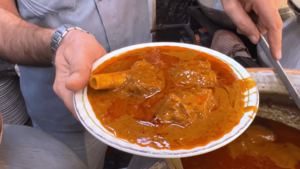Nihari facts for kids
|
Nihari serving in Old Delhi, India
|
|
| Course | Breakfast, lunch, dinner |
|---|---|
| Place of origin | Indian subcontinent |
| Region or state | Lucknow, Awadh |
| Associated national cuisine | Indian, Pakistani, Bangladeshi |
| Invented | 18th century |
| Serving temperature | Hot |
| Main ingredients | Shank cut of, beef, ,(mainly in Pakistan), lamb and mutton, goat meat, or camel meat, as well as chicken and bone marrow |
| Other information | Served with naan or rice |
Nihari is a delicious and popular stew from the Indian subcontinent. It started in Lucknow, a city in India, way back in the 1700s. This tasty dish is made by slow-cooking meat until it's super tender. People usually use beef, lamb, goat, or even chicken. It's often flavored with a special spice called long pepper, which is like a cousin to black pepper.
Contents
Where the Name Nihari Comes From
The word "Nihari" comes from the Arabic word nahâr. This word means "morning." That's because Nihari was first eaten as a breakfast meal. Important people called nawabs in the Mughal Empire enjoyed it for breakfast after their morning prayers.
The History of Nihari
How Nihari Began
Many people believe that Nihari was first made in the royal kitchens of Lucknow, in a region called Awadh. This was in the late 1700s, when the Mughal Empire was nearing its end.
From Workers to Royalty
Nihari was first created as a hearty breakfast. It gave working people lots of energy, especially in cold weather. But this delicious dish soon became very popular. It even became a favorite meal for the royal families of the Mughal Empire.
Nihari Today
Nihari grew along with the food traditions of the Muslims in the Indian subcontinent. It is still a very popular dish today. You can find it in places like Old Delhi, Lucknow, Dhaka, and Chittagong. People love Nihari for its spicy flavor, rich taste, and thick gravy.
Nihari's Popularity
Spreading Across Countries
Nihari is a traditional dish for Indian Muslim communities in cities like Lucknow, Delhi, and Bhopal. After India was divided in 1947, many Urdu-speaking Muslims moved to Karachi in Pakistan and Dhaka in Bangladesh. They opened many restaurants that served Nihari. In Karachi, Nihari became a huge hit and quickly became famous all over Pakistan.

The "Taar" Tradition
Some restaurants have a special tradition with Nihari. They add a few kilograms of leftover Nihari from one day to the pot for the next day. This reused part of the dish is called taar. People believe that taar gives the Nihari a unique and even better flavor. Some Nihari shops in Old Delhi say they have kept this taar cycle going for more than a hundred years!
Nihari as a Home Remedy
Nihari is sometimes used as a home remedy in some cultures. People believe it can help with things like fever, a runny nose, and the common cold.
See also
 In Spanish: Nihari para niños
In Spanish: Nihari para niños


